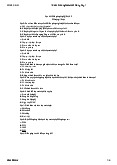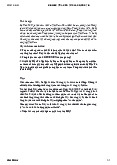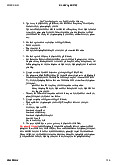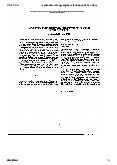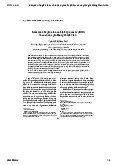










Preview text:
22:41 30/7/24 Completion
How atoms were discovered
Hundreds of years ago in 1785 Dutch scientist Jan Ingenhousz was studying a strange phenomenon
that he couldn’t quite make sense of. Minute particles of coal dust were darting about on the surface of some alcohol in his lab.
About 50 years later, in 1827, the Scottish botanist Robert Brown described something curiously
similar. He had his microscope trained on some pollen grains. Brown noticed that some of the
grains released tiny particles – which would then move away from the pollen grain in a random jittery dance.
At first, Brown wondered if the particles were really some sort of unknown organism. He repeated
the experiment with other substances like rock dust, which he knew wasn’t alive, and saw the same strange motion again.
It would take almost another century for science to offer an explanation. Einstein came along and
developed a mathematical formula that would predict this very particular type of movement – by
then called Brownian motion, after Robert Brown.
Einstein’s theory was that that the particles from the pollen grains were being moved around
because they were constantly crashing into millions of tinier molecules of water – molecules that were made of atoms.
By 1908, observations backed with calculations had confirmed that atoms were real. Within about a
decade, physicists would be able to go further. By pulling apart individual atoms they began to get a
sense of their internal structure.
It might come as a surprise that atoms can be broken down – particularly since the very name atom
derives from a Greek term “atomos”, which means “indivisible”. But physicists now know that
atoms are not solid little balls. It’s better to think of them as tiny electrical, “planetary” systems.
They’re typically made up of three main parts: protons, neutrons and electrons. Think of the protons
and neutrons as together forming a “sun”, or nucleus, at the centre of the system. The electrons orbit this nucleus, like planets.
1. The type of random jittery movement of tiny particles is called .......................... .
2. Einstein explained the phenomenon of particles' strange motion by the fact that they were collapsing with
3. Nowadays, scientists consider atoms' structures similar to tiny .......................... .
4. .......................... are parts that are circling around the nucleus.
European Settlement of Australia
European settlement of Australia began in 1788 when a British penal colony was established on the
east coast. From this starting point Australia grew rapidly and continually, expanding across the entire continent.
A number of reasons contributed to Britain's decision to colonise Australia. The most important
factor was Britain's need to relieve its overcrowded prisons. Several violent incidents at
overcrowded prisons convinced the British government of the need to separate unruly elements
from the rest of the prison populace. about:blank 1/11 22:41 30/7/24 Completion
Additionally, Australia was of strategic importance to Britain, and it provided a base for the Royal
Navy in the eastern sea. Also, Australia could be used as an entry point to the economic
opportunities of the surrounding region. All these points figured in the decision by Lord Sydney,
secretary of state of home affairs, to authorise the colonisation.
To this affect, on May 13, 1787, Captain Arthur Phillip, commanding eleven ships full of convicts,
left Britain for Australia. He successfully landed a full fleet at Botany Bay on January 18, 1788.
However, they left the bay eight days later because of its openness and poor soil, and settled instead
at Port Jackson, a few kilometres north. The ships landed 1,373 people, including 732 convicts, and
the settlement became Sydney. Australia Day is now celebrated on 26 January each year, to
commemorate this first fleet landing.
1. Australia was originally founded as a…..
2. . The major consideration in colonizing Australia was Britain’s
3. It was thought that ….. could be gained in that part of the world due to the access provided via Australia.
4. Lord Sydney took every factor into account when he gave official permission for the …. of Australia.
5. . Botany Bay was abandoned by the settlers due to the lack of cover and
Hydroelectric plants harness
energy by passing flowing water through a turbine. The water
turbine rotation is delivered to a generator ,
which generates electricity. The quantity of
electricity that can be produced at a hydroelectric plant relies upon two variables. These variables
are (1) the vertical distance that the water falls, called the “head”, and (2) the flow rate, calculated
as volume over time. The amount of electricity that is produced is thus proportional to the head
product and the flow rate. Until only recently people believed almost that universally hydroelectric
power was an environmentally safe and clean means of generating electricity. Hydroelectric
stations do not release any of the usual atmospheric pollutants emitted by power plants fuelled by
fossil fuels so they do not add to global warming or acid rain. Nevertheless, recent studies of the
larger reservoirs formed behind dams have implied that decomposing, flooded vegetation could
give off greenhouse gases equal to those from other electricity sources.
Hydroelectric plants produce energy by passing 1.……water………………….. through a turbine.
Electricity is produced by delivering water 2..…… turbine rotation ……………. to a generator.
The amount of electricity that can be produced at a hydroelectric plant relies upon 3…… vertical
distance…………. and 4………flow rate……… Hydroelectric power plants do not release any
pollutants into the atmosphere, so they do not cause 5…… global warming or acid rain…………….
By the early nineteenth century –
the start of the railway age
– men such as John McAdam and
Thomas Telford had created a British road network totalling some 200,000 km, of which about one
sixth was privately owned toll roads called turnpikes. In the first half of the nineteenth century,
many roads in the US were built to the new standards, of which the National Pike from West
Virginia to Illinois was perhaps the most notable. In the twentieth century, the ever-increasing
use of motor vehicles threatened to break up roads built to nineteenth-century standards, so new
techniques had to be developed.On routes with heavy traffic, flexible pavements were replaced by about:blank 2/11 22:41 30/7/24 Completion
rigid pavements, in which the top layer was concrete, 15 to 30
centimeters thick, laid on a
prepared bed. Nowadays steel bars are laid within the concrete. This not only restrains shrinkage
during setting, but also reduces expansion in warm weather. As a result, it is, possible to lay long
slabs without danger of cracking Complete the table below.
Use ONE WORD ONLY from the passage for each answer. Time Period Type of Roads Early 19th century
Turn pikes also called as 1……… roads
First half of the 2………19th………. National Pike century 20th century
flexible pavements were replaced by 3…….. pavements Now
4…bars are laid within the concrete
A. Shortly after World War II, ‘development’ as we now understand it was set in motion. Western
governments and donors poured money into new agencies that set about trying to stimulate the
economies of underdeveloped countries. Because of this emphasis, it is now widely regarded as the
Growth Model. Although we might expect poverty reduction to be the central objective, planners at
this stage were primarily concerned with industrial development. It was hoped that the benefits of
this would trickle down to poor people through raising incomes and providing employment
opportunities, thereby indirectly lifting them above the ascribed poverty threshold of a dollar a day.
The weaknesses of these assumptions were revealed, however, when poverty rates and economic
growth were found to rise simultaneously in many countries.
B. During the 1970s, a new trend took over – trickle-up development. Instead of focusing on
macroeconomic policy and large-scale industrial projects, planners shifted attention to the core
living requirements of individuals and communities. This became known as the Basic Needs
Approach to development. It was hoped that through the provision of services such as community
sanitation and literacy programmes, poverty could be eliminated from below. Economic growth was
desirable but superfluous – Basic Needs redefined poverty from involving a lack of money to
lacking the capability to attain full human potential. The trouble with Basic Needs programmes,
however; was their expensive, resource-intensive nature that entailed continuous management and funding Questions 1-5 Complete the table below. about:blank 3/11 22:41 30/7/24 Completion
Choose NO MORE THAN TWO WORDS from the passage for each answer.
Write your answers in blank spaces next to 1-5 on your answer sheet. Growth Model Basic Needs Approach
1…………………….. was the main
Typified by small-scale aid such
Goal 2………………………
as health and 3…………………. Poverty described as living
Poverty is seen as an inability to On less than a dollar a day reach 4………………
Despite the earlier success, however, negative repercussions of human activity have caused the
return of water hyacinth to East African waters. Uganda’s Lake Kyoga has recently once again
experienced problems with the infestation. Sewage and agricultural waste making their way into the
waterways and thereby creating an excess of nutrients in the water has been the main contributing
factors to the re-emergence of water hyacinth. In addition, high levels of nitrogen in rainfall, which
enter the water cycle from the smoke created by wood-burning, cooking fires used in the region,
also serve as nutrition to the increasing plant population. Restriction of human activity on lakes
such as this, caused by the infestation of water hyacinth, has enormous implications; villages such
as Kayago, which is close to the lake, are often almost entirely dependent on fishing activity for their economy and food source. Questions:
Choose No More Than Two Words from the passage to complete the sentences.
1.The negative repercussions of human activities have led to the restoration of water
hyacinth to the waters in ____________.
2. Recently, Uganda’s Kyoga lake experienced problems with ____________.
3. _______and_______ are creating an excess of nutrients in the water as contributing factors. about:blank 4/11 22:41 30/7/24 Completion
4. Wood burning and cooking fires serve as nutrition to the rising ______________.
5. Kayago completely depends on _________ for their economy and food source.
Some people believe that traditional usages of language are always more superior and refined than
modern variations even when the reasons behind the rule were dubious in the first place. For
example, it was once seriously frowned upon to split an infinitive in a sentence, and even today it is
considered grammatically incorrect to do so. To demonstrate, let’s consider the following sentence:
‘The examiner asked me to quietly leave the room’; this was considered incorrect as the word
‘quietly’ splits the infinitive of the verb ‘to leave.’ The origins of this rule hail back to the 17th
century when scholars believed that the English language should be adapted to follow Latin rules;
then considered the perfect language. Since splitting infinitives in Latin is impossible, it was
decided that splitting infinitives in English, even though possible, was not acceptable, Given those
initial motivations behind the rule were questionable. The clarity of the meaning of the sentence is
not compromised in the ‘incorrect’ form, it could be argued that this grammar rule is a prime
example of an unnecessary sanction that is likely to be abandoned in the future. Questions:
Choose No More Than Two Words from the passage to complete the sentences.
1.Traditional use of languages are said to be more ________ and _________.
2. Scholars affirmed that the English language should be adapted to follow the rules of ___________.
3. Even though splitting infinitives in English was possible, it was not ____________.
4. Rules like splitting infinitives are considered as _____________.
5. Split infinitives are likely to be ____________ in future.
There are some tips for helping your bodywork with your circadian rhythm. First thing in the
morning take a short walk outside or open all the curtains to get as much light as possible through
the eyes and into the brain. Lighting levels that affect circadian rhythm in humans are higher than
the levels usually used in artificial lighting in homes. In addition to the strength of the light,
wavelength (or colour) of light is a factor, the best being that present in sunlight. Plan your work
and other activities around the highs and lows of your temperature rhythm. For example, plan easier
activities for first thing in the morning when you’re not operating at your physical best. Late
morning is better for challenging tasks. After lunch, you may feel like nodding off. Take scheduled
breaks. The best time to exercise is in the late afternoon – your body temperature reaches its daily
high, it is warmed up and stretched from spending your day at work. Avoid driving during sleep
times. Sleepy drivers should stop for a nap – playing loud music or leaving windows open is an
overrated misconception. At night, close the blinds and curtains and sleep in a dark room. If you about:blank 5/11 22:41 30/7/24 Completion
work the night shift, use bright lights and music in the workplace to keep your brain alert. Wear an
eye mask to block out the light when you want to go to sleep. Questions:
Choose No More Than Two Words from the passage to complete the sentences.
1.Taking a short walk in the morning can help your bodywork with your ________.
2. It is better to plan the physical activities and work schedules around the ______and
_____ of your temperature rhythm.
3. Lighting levels impacting the circadian rhythm in humans are ________.
4. The best time to do the demanding tasks of the day is in the _____________.
5. Playing loud music and leaving the windows open is an overrated ___________.
Over the last decade, many brands and companies catering for enhancement of the male image have
been successfully established, such operations ranging from male-only spas, boutiques, personal
hygiene products, hair and skincare ranges, and male magazines with a strong leaning towards
men’s fashion. Jamie Cawley, a proprietor of a successful chain of London-based male grooming
boutiques, holds that his company’s success in this highly competitive market can be attributed to
the ‘exclusivity’ tactics they have employed, in that their products and services are clearly defined
as male- orientated and distinctly separate to feminine products offered by other organizations.
However, market analyst, Kim Sawyer, believes that future growth in the market can also be
achieved through the sale of unisex products marketed to both genders; this strategy is becoming
increasingly easy to implement as men’s interest in appearance and grooming has become more of a social norm. Questions:
Choose No More Than Two Words from the passage to complete the sentences.
1.A large number of companies and big brands are catering for the enhancement of male
image by establishing _____________ centers.
2. These operations have been set up with a strong leaning towards ____________.
3. Jamie Cawley claims that his company’s success in this highly competitive market can
be credited to the ____________ tactics.
4. The products and services rendered by Cawley’s company were defined as ___________. about:blank 6/11 22:41 30/7/24 Completion
5. Kim sawyer affirms that the growth in the future market will be achieved through the sale of ________.
Clinical depression was originally solely attributed to a chemical imbalance in the brain.
While anti-depressant drugs which work to optimize levels of ‘feel-good’ chemicals –
serotonin and norepinephrine – are still commonly prescribed today, experts now believe
that onset of depression may be caused by a number, and often combination of,
physiological and socio-psychological factors. Treatment approaches vary quite
dramatically from place to place and are constantly tailored to an individual’s particular
situation; however, some variation of a combination of medication and psychotherapy is
most commonly used. The more controversial electroconvulsive therapy (ECT) may also
be used where initial approaches fail. In extreme cases, where an individual exhibits
behaviour that indicates that they may cause physical harm to themselves, psychiatric
hospitalization may be necessary as a form of intensive therapy. Questions:
Choose No More Than Two Words from the passage to complete the sentences.
1.Onset of depression is caused by __________ and _________ factors.
2. _______ and ________ are a class of effective medication in treating depression.
3. When initial approaches fail in a person with severe depression, _________ is used.
4. __________ is most commonly used to treat patients with mental health problems.
5. An individual who could harm himself must be under psychiatric hospitalization, which is also a form of ________.
In Australia, the platypus is officially classified as ‘Common but Vulnerable.’ As a species, it is not
currently considered to be endangered. However, platypus populations are believed to have declined
or disappeared in many catchments 1, particularly in urban and agricultural landscapes. In most
cases, the specific underlying reasons for the reduction in numbers remain unknown. Platypus
surveys have only been carried out in a few catchments in eastern Australia. It is, therefore,
impossible to provide an accurate estimate of the total number of platypus remaining in the wild.
Based on recent studies, the average platypus population density along relatively good quality
streams in the foothills of Victoria’s Great Dividing Range is only around one to two animals per
kilometer of the channel. Because platypus is predators near the top of the food chain and requires
large amounts of food to survive (up to about 30% of a given animal’s body weight each day), it is
believed that their numbers are most often limited by the availability of food, mainly in the form of
bottom-dwelling aquatic invertebrates such as shrimps, worms, yabbies, pea-shell mussels, and about:blank 7/11 22:41 30/7/24 Completion
immature and adult aquatic insects. Small frogs and fish eggs are also eaten occasionally, along
with some terrestrial insects that fall into the water from overhanging vegetation. Catchments are an
area of land drained by a creek or river system or a place set aside for collecting water that runs off the land’s surface. Questions:
Choose NO MORE THAN TWO WORDS from the passage for each answer.
1.Although Platypus is not endangered, it is considered as __________.
2. The Platypus population in ______ and ________ environment has disappeared in most of the catchments.
3. According to the recent survey, the number of platypi that can be found in the foothills
of Victoria’s great dividing range is just ____ or _____..
4. Platypus mostly eats food in the form of bottom-dwelling _______________.
5. The platypus needs to eat about 30% of the animal’s body weight each day to ___________.
It took 300 workers and 15,000 pieces of iron to complete this massive landmark which
now stands at 320 meters tall. The third and highest level offers panoramic views of the
City of Paris and sits 276 meters above the ground with three different levels. Today all
three levels of the Eiffel Tower are observatory platforms. The first level offers a souvenir
kiosk, gallery, and restaurant. The second level provides telescopes, shops, and another
restaurant with even more spectacular views; the third provides a gallery featuring the
Eiffel Tower’s history, a wax reproduction of Gustave Eiffel, and his original office
restoration. Although stairs are still available, lifts commonly take passengers to all three of these levels. Questions:
Choose NO MORE THAN TWO WORDS from the passage for each answer.
1. A total of 300 workers and 15,000 iron pieces were required to complete the construction of ___________.
2. There are three different levels in the Eiffel Tower which are all the ___________________.
3. The topmost platform is ______ above the ground. about:blank 8/11 22:41 30/7/24 Completion
4. A gallery, restaurant, and a souvenir kiosk is located in the _________.
5. The summit features a history of the Eiffel Tower along with a ___________ of Gustave Eiffel.
Roller coasters have a long, fascinating history. The direct ancestors of roller coasters were
monumental ice slides – long, steep wooden slides covered in ice, some as high as 70 feet – popular
in Russia in the 16th and 17th centuries. Riders shot down the slope in sleds made out of wood or
blocks of ice, crash-landing in a sand pile. Coaster historians diverge on the exact evolution of these
ice slides into actual rolling carts. The most widespread account is that a few entrepreneurial
Frenchmen imported the ice slide idea to France. The warmer climate of France tended to melt the
ice, so the French started building waxed slides instead, eventually adding wheels to the sleds. In
1817, the Russes a Belleville (Russian Mountains of Belleville) became the first roller coaster
where the train was attached to the track (in this case, the train axle fit into a carved groove). The
French continued to expand on this idea, coming up with more complex track layouts, with multiple
cars and all sorts of twists and turns. Question:
Choose NO MORE THAN TWO WORDS from the passage for each answer.
1.Roller coasters originated from ____________.
2. The french men modified the melted ice into _______.
3. The predecessor to the roller coaster was the ______________.
4. The snow riders used __________ or block of ice and slid down the ice-covered hills,
crash-landing into a sand-pile.
5. It was the ________ who expanded the idea of roller coasters with more complex track layouts.
The spread of railways stimulated communication, and Rowland Hill’s standardisation of
postal charges in 1839 saw a boom in mail services. But this was nothing compared to the
revolution of the telegraph. If you think the Internet is big then just imagine how much
bigger it would seem if you had never before seen a computer or telephone. That’s what
the telegraph was to the Victorians. If rail travel shrank the country, the telegraph crushed
it. It opened in the 1840s and soon went stratospheric – within ten years exchanging
telegrams had become part of everyday life. By the mid-1860s London was connected with
New York and ten years later messages could be exchanged between London and Bombay in minutes. about:blank 9/11 22:41 30/7/24 Completion Complete the table below.
Choose NO MORE THAN TWO WORDS AND/OR A NUMBER from the passage for each answer.
Across Europe similar academies and societies arose, creating new national traditions
of science. In the initial stages of the scientific revolution, most publications in the national
languages were popular works, encyclopaedias, educational textbooks and translations.
Original science was not done in English until the second half of the 17th century. For
example, Newton published his mathematical treatise, known as the Principia, in Latin, but
published his later work on the properties of light – Opticks – in English. There were
several reasons why original science continued to be written in Latin. The first was simply
a matter of audience. Latin was suitable for an international audience of scholars, whereas
English reached a socially wider, but more local audience. Hence, popular science was
written in English. A second reason for writing in Latin’ may, perversely, have been a concern for secrecy. about:blank 10/11 22:41 30/7/24 Completion
Open publication had dangers in putting into the public domain preliminary ideas which
had not yet been fully exploited by their ‘author’. This growing concern about intellectual
property rights was a feature of the period – it reflected both the humanist notion of the
individual, rational scientist who invents and discovers through private intellectual labour,
and the growing connection between original science and commercial exploitation. There
was something of a social distinction between ‘scholars and gentlemen’ who understood
Latin, and men of trade who lacked a classical education. And in the mid-17fh century it
was common practice for mathematicians to keep their discoveries and proofs secret, by
writing them in cipher, in obscure languages, or in private messages deposited in a sealed
box with the Royal Society. Some scientists might have felt more comfortable with Latin
precisely because its audience, though international, was socially restricted. Complete the table. Choose
from the passage for each answer.
Write your answers in boxes 1-4 on your answer sheet. Type of Original
1…………………………… Science Examples
2………………………….. Encyclopedias International scholars Target 4. Socially
3……………………., but socially wider audience ……………….. about:blank 11/11
